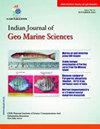阿拉伯海中部海面叶绿素对气溶胶沙尘输入的响应
IF 0.5
4区 地球科学
Q4 Earth and Planetary Sciences
引用次数: 0
摘要
在阿拉伯海中部的一个独特区域,结合气溶胶光学深度(AOD),研究了卫星获得的地表叶绿素的年年趋势,该区域在夏末季风期间模仿高营养和低叶绿素(HNLC)的情况。分析表明,在研究地区有两次季节性的水华,可能与不同的生物地球化学过程有关。此外,每年7月的矿物粉尘沉积与地表叶绿素的增加相吻合,然后是一个滞后期,直到冬季季风。正如AOD粉尘数据所表明的那样,在风沙输入后浮游植物生物量的快速增加可能是由于混合层中可溶性铁的增加。最有可能的是,如前所述,这种生物量的快速增加可能会导致可溶性铁的进一步消耗,从而在夏末季风期间导致类似hnlc的情况。这一假设与卫星观测相一致,卫星观测显示,在随后的几个月里,直到12月至1月(冬季季风)之间的对流混合,地表叶绿素都在减少。研究表明,夏季风期间阿拉伯海中部HNLC区域的存在不像南大洋那样是常年存在的。相反,这是一种暂时的现象,主要由气溶胶沉积和可溶性铁的快速吸收控制,正如美国宇航局海洋生物地球化学模型(NOBM)最近的结果所表明的那样,这促进了硅藻的繁殖。本文章由计算机程序翻译,如有差异,请以英文原文为准。
Response of surface chlorophyll to aerosol dust input in the Central Arabian Sea
The decadal trends in satellite-derived surface chlorophyll in conjunction with Aerosol Optical Depth (AOD) are explored in a unique area in the central Arabian Sea, known to mimic High Nutrient and Low Chlorophyll (HNLC) like conditions during late summer monsoon. The analysis indicates two recurring seasonal blooms, possibly associated with distinct biogeochemical processes in the studied region. Furthermore, the mineral dust deposition in July every year coincides with one such increase in surface chlorophyll followed by a lag period until winter monsoon. This rapid increase in the phytoplankton biomass just after the aeolian input is possibly due to an enhancement in soluble iron within the mixed layer, as suggested by AOD dust data. Most likely, this rapid increase in biomass may induce further depletion of soluble iron leading to HNLC-like conditions during the late Summer Monsoon, as reported earlier. This hypothesis is consistent with the satellite observation, which shows a decrease in surface chlorophyll during subsequent months until the convective mixing between December – January (winter monsoon). The study reveals that the presence of the HNLC region in the central Arabian Sea during the summer monsoon is not perennial like the Southern Ocean. Instead, it is a transient phenomenon primarily controlled by aerosol deposition and rapid uptake of soluble iron, which facilitate the diatom blooms as suggested by the recent output from the NASA Ocean Biogeochemical Model (NOBM).
求助全文
通过发布文献求助,成功后即可免费获取论文全文。
去求助
来源期刊
CiteScore
1.50
自引率
0.00%
发文量
0
审稿时长
1.7 months
期刊介绍:
Started in 1972, this multi-disciplinary journal publishes full papers and short communications. The Indian Journal of Geo-Marine Sciences, issued monthly, is devoted to the publication of communications relating to various facets of research in (i) Marine sciences including marine engineering and marine pollution; (ii) Climate change & (iii) Geosciences i.e. geology, geography and geophysics. IJMS is a multidisciplinary journal in marine sciences and geosciences. Therefore, research and review papers and book reviews of general significance to marine sciences and geosciences which are written clearly and well organized will be given preference.

 求助内容:
求助内容: 应助结果提醒方式:
应助结果提醒方式:


